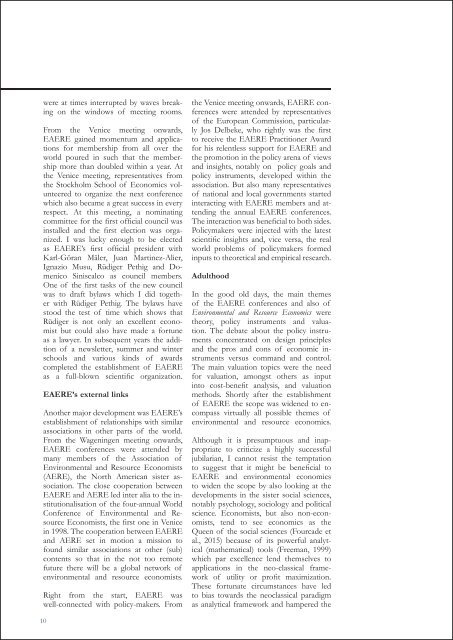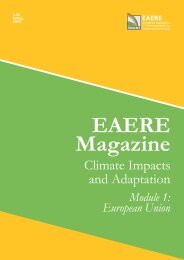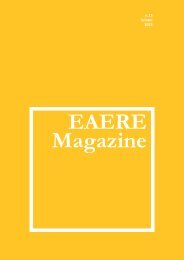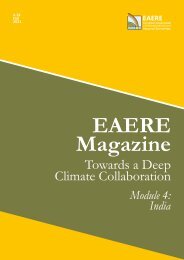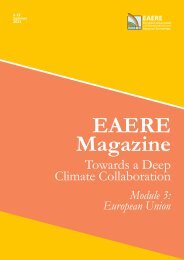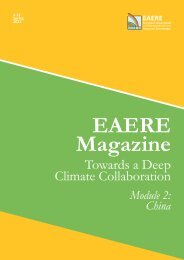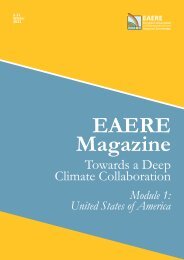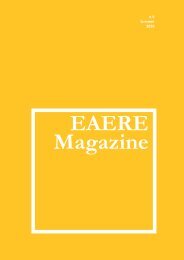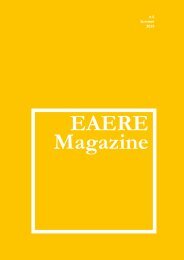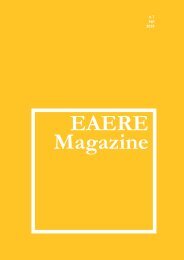EAERE Magazine - n.8 Winter 2020
Create successful ePaper yourself
Turn your PDF publications into a flip-book with our unique Google optimized e-Paper software.
were at times interrupted by waves breaking<br />
on the windows of meeting rooms.<br />
From the Venice meeting onwards,<br />
<strong>EAERE</strong> gained momentum and applications<br />
for membership from all over the<br />
world poured in such that the membership<br />
more than doubled within a year. At<br />
the Venice meeting, representatives from<br />
the Stockholm School of Economics volunteered<br />
to organize the next conference<br />
which also became a great success in every<br />
respect. At this meeting, a nominating<br />
committee for the first official council was<br />
installed and the first election was organized.<br />
I was lucky enough to be elected<br />
as <strong>EAERE</strong>’s first official president with<br />
Karl-Göran Mäler, Juan Martinez-Alier,<br />
Ignazio Musu, Rüdiger Pethig and Domenico<br />
Siniscalco as council members.<br />
One of the first tasks of the new council<br />
was to draft bylaws which I did together<br />
with Rüdiger Pethig. The bylaws have<br />
stood the test of time which shows that<br />
Rüdiger is not only an excellent economist<br />
but could also have made a fortune<br />
as a lawyer. In subsequent years the addition<br />
of a newsletter, summer and winter<br />
schools and various kinds of awards<br />
completed the establishment of <strong>EAERE</strong><br />
as a full-blown scientific organization.<br />
<strong>EAERE</strong>’s external links<br />
Another major development was <strong>EAERE</strong>’s<br />
establishment of relationships with similar<br />
associations in other parts of the world.<br />
From the Wageningen meeting onwards,<br />
<strong>EAERE</strong> conferences were attended by<br />
many members of the Association of<br />
Environmental and Resource Economists<br />
(AERE), the North American sister association.<br />
The close cooperation between<br />
<strong>EAERE</strong> and AERE led inter alia to the institutionalisation<br />
of the four-annual World<br />
Conference of Environmental and Resource<br />
Economists, the first one in Venice<br />
in 1998. The cooperation between <strong>EAERE</strong><br />
and AERE set in motion a mission to<br />
found similar associations at other (sub)<br />
contents so that in the not too remote<br />
future there will be a global network of<br />
environmental and resource economists.<br />
Right from the start, <strong>EAERE</strong> was<br />
well-connected with policy-makers. From<br />
the Venice meeting onwards, <strong>EAERE</strong> conferences<br />
were attended by representatives<br />
of the European Commission, particularly<br />
Jos Delbeke, who rightly was the first<br />
to receive the <strong>EAERE</strong> Practitioner Award<br />
for his relentless support for <strong>EAERE</strong> and<br />
the promotion in the policy arena of views<br />
and insights, notably on policy goals and<br />
policy instruments, developed within the<br />
association. But also many representatives<br />
of national and local governments started<br />
interacting with <strong>EAERE</strong> members and attending<br />
the annual <strong>EAERE</strong> conferences.<br />
The interaction was beneficial to both sides.<br />
Policymakers were injected with the latest<br />
scientific insights and, vice versa, the real<br />
world problems of policymakers formed<br />
inputs to theoretical and empirical research.<br />
Adulthood<br />
In the good old days, the main themes<br />
of the <strong>EAERE</strong> conferences and also of<br />
Environmental and Resource Economics were<br />
theory, policy instruments and valuation.<br />
The debate about the policy instruments<br />
concentrated on design principles<br />
and the pros and cons of economic instruments<br />
versus command and control.<br />
The main valuation topics were the need<br />
for valuation, amongst others as input<br />
into cost-benefit analysis, and valuation<br />
methods. Shortly after the establishment<br />
of <strong>EAERE</strong> the scope was widened to encompass<br />
virtually all possible themes of<br />
environmental and resource economics.<br />
Although it is presumptuous and inappropriate<br />
to criticize a highly successful<br />
jubilarian, I cannot resist the temptation<br />
to suggest that it might be beneficial to<br />
<strong>EAERE</strong> and environmental economics<br />
to widen the scope by also looking at the<br />
developments in the sister social sciences,<br />
notably psychology, sociology and political<br />
science. Economists, but also non-economists,<br />
tend to see economics as the<br />
Queen of the social sciences (Fourcade et<br />
al., 2015) because of its powerful analytical<br />
(mathematical) tools (Freeman, 1999)<br />
which par excellence lend themselves to<br />
applications in the neo-classical framework<br />
of utility or profit maximization.<br />
These fortunate circumstances have led<br />
to bias towards the neoclassical paradigm<br />
as analytical framework and hampered the<br />
10


